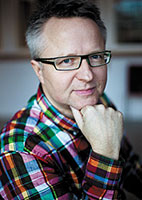Artificial intelligence that imitates children's learning

Claes Strannegård, Associate Professor, University of Gothenburg
However, a research team from Gothenburg, Sweden, has now been able to create an AI program that can learn how to solve problems in many different areas. The program is designed to imitate certain aspects of children’s cognitive development.
Traditional AI programs lack the versatility and adaptability of human intelligence. For example, they cannot come into a new home and cook, clean and do laundry.
In artificial general intelligence (AGI), which is a new field within AI, scientists try to create computer programs with a generalised type of intelligence, enabling them to solve problems in vastly different areas. Gothenburg has a leading research team in this domain. In August, ‘exceptional contributions to the AGI field’ earned a team of researchers from the University of Gothenburg and Chalmers University of Technology the Kurzweil Prize for the second straight year.
No pre-existing knowledge
‘We have developed a program that can learn for example basic arithmetic, logic and grammar without any pre-existing knowledge,’ says Claes Strannegård, a member of the research team together with Abdul Rahim Nizamani and Ulf Persson.
The best example of general intelligence that we know of today is the human brain, and the scientists’ strategy has been to imitate, at a very fundamental level, how children develop intelligence. Children can learn a wide range of things. They build new knowledge based on previous knowledge and they can use their total knowledge to draw new conclusions. This is exactly what the scientists wanted their program to be able to do.
Children learn based on experience
‘We postulate that children learn everything based on experiences and that they are always looking for general patterns,’ says Strannegård.
A child who for example is learning multiplication and who knows that 2 x 0 = 0 and 3 x 0 = 0 can identify a pattern and conclude that also 17 x 0 = 0. However, sometimes this method backfires. If the child knows that 0 x 0 = 0 and 1 x 1 = 1, he or she can incorrectly conclude that 2 x 2 = 2. As soon as the child realises that a certain pattern can lead to incorrect conclusions, he or she can simply stop applying it.
Identify patterns
The child can in this way create a large number of patterns not only in mathematics but also in other areas such as logic and grammar. The patterns in a certain area can then be combined with each other and make it possible to solve entirely new problems. The programme developed by the Gothenburg scientists works in a similar manner. It can identify patterns by itself and therefore differs from programmes where a programmer has to formulate which rules the programme should apply.
‘We are hoping that this type of programme will eventually be useful in several different practical applications. Personally, I think a versatile household robot would be tremendously valuable, but we’re not there yet,’ says Strannegård.
The research team:
Claes Strannegård, Associate Professor at the Department of Philosophy, Linguistics and Theory of Science, University of Gothenburg, and at the Department of Applied Information Technology, Chalmers University of Technology
Abdul Rahim Nizamani, doctoral student at the Department of Applied Information Technology, University of Gothenburg
Ulf Persson, Professor at the Department of Mathematical Sciences, Chalmers University of Technology
Contact information:
Claes Strannegård, tel. +46 (0)707 527869, e-mail claes.strannegard@gu.se
http://gu.se/english/about_the_university/news-calendar/News_detail/?languageId=…
Media Contact
All latest news from the category: Information Technology
Here you can find a summary of innovations in the fields of information and data processing and up-to-date developments on IT equipment and hardware.
This area covers topics such as IT services, IT architectures, IT management and telecommunications.
Newest articles

Largest magnetic anisotropy of a molecule measured at BESSY II
At the Berlin synchrotron radiation source BESSY II, the largest magnetic anisotropy of a single molecule ever measured experimentally has been determined. The larger this anisotropy is, the better a…

Breaking boundaries: Researchers isolate quantum coherence in classical light systems
LSU quantum researchers uncover hidden quantum behaviors within classical light, which could make quantum technologies robust. Understanding the boundary between classical and quantum physics has long been a central question…

MRI-first strategy for prostate cancer detection proves to be safe
Active monitoring is a sufficiently safe option when prostate MRI findings are negative. There are several strategies for the early detection of prostate cancer. The first step is often a…



